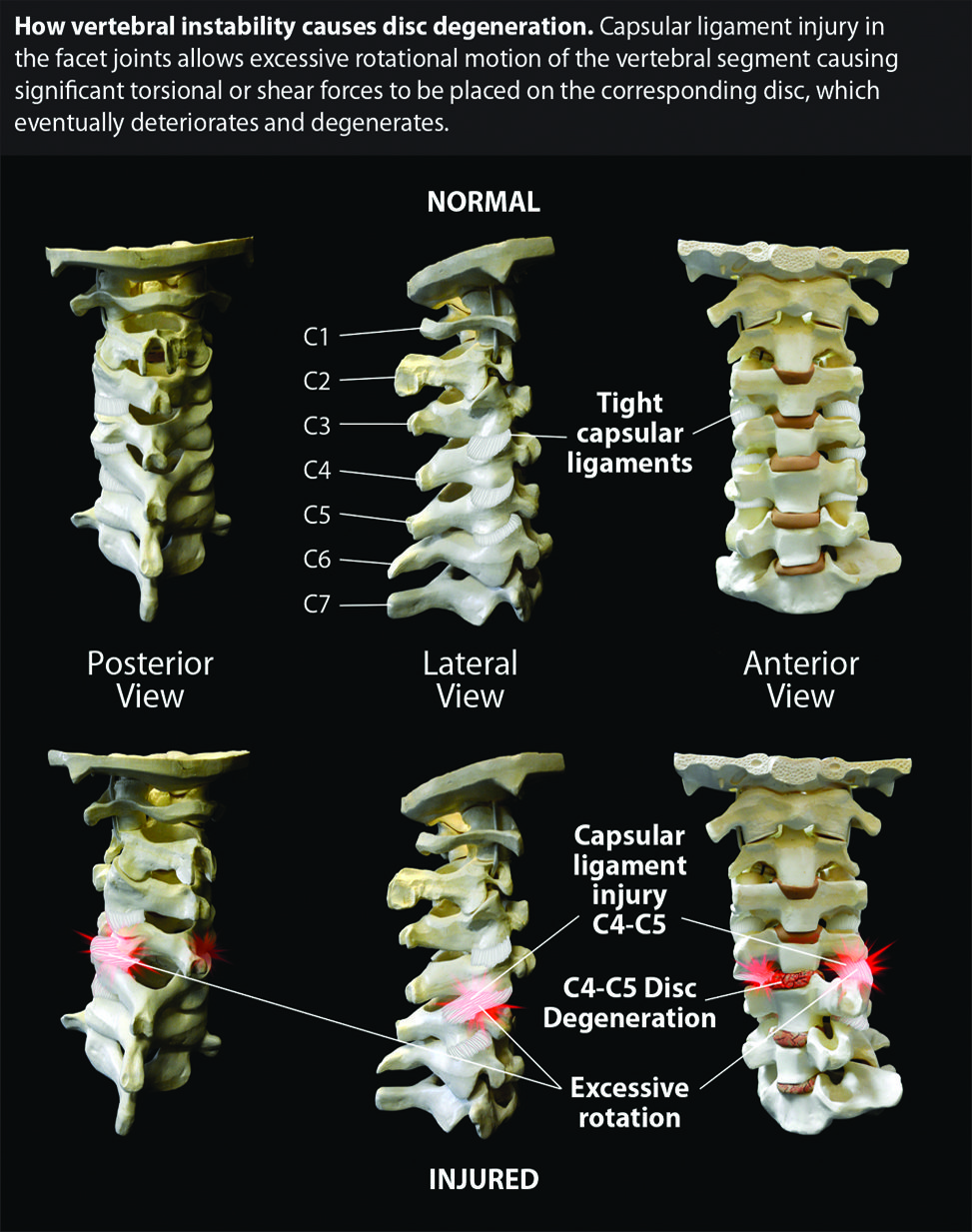By Ross A. Hauser, MD
Cervical instability is associated with numerous medical conditions, including chronic headaches, migraines, whiplash-associated disorder and post-concussion syndrome, and can produce a myriad of disabling symptoms. (See figure 1.)


Yet so many people suffer through the years, receiving treatments that chase the symptoms and, at best, only provide temporary relief, while not treating or entirely missing the underlying cervical instability and its manifestations. Fortunately, there are options to objectively document cervical instability, to strengthen underlying ligament weakness with regenerative injection therapy, and to re-establish normal biomechanics and restoration of the proper cervical curve with alignment therapies.
Ligaments Are Key to a Stable Spine
The cervical spine does not have the large stabilizing muscles that the low back has, so it relies on ligaments and discs for stabilization. The upper cervical spine has no discs and relies solely on the capsular ligaments. When the ligaments overstretch and/or tear from injuries, such as whiplash, spinal motion becomes excessive and can lead to cervical instability. (See figure 2.)


When the cervical spine is unstable, the body attempts to stabilize it in order to protect sensitive structures, including nerves and the spinal cord, by recruiting the surrounding muscles. Since cervical muscles are small, they
fatigue easily, which causes significant pain, stiffness, and tightness of the neck.
Cervical Instability and an Abnormal Curve
As the ligament injury continues, the cervical vertebrae then sublux, or move, anteriorly causing a straightening (military spine) of the cervical spine. Without proper treatment, ligament injuries allow the permanent straightening and, eventually, the
reversal of the cervical curve (kyphosis). The upper cervical vertebrae also go into extension, as the neck attempts to keep a person’s eyes facing forward (versus downward). This is termed an “S” curve. The normal cervical spine looks like a “C” and this position is called lordosis. (See figure 3.)


This curve is essential! When a person loses this curve, the forces can increase 5-10 times on the vertebrae and cervical discs.
The destructive joint forces that occur in the cervical spine because of a loss of the normal curve and the ligament laxity which initiated the process, perpetuate the condition. As the tissue weakens further, destructive joint motions are produced every time the joint is used, creating a vicious cycle of worsening joint destruction and pain.
Resolving Cervical Instability with Regenerative Injection Therapy
(Prolotherapy) and Cervical Realignment
Cervical instability should be considered as the possible missing diagnosis for patients who have unresolved symptoms such as headaches, neck pain, dizziness, vertigo, and other head and neck symptoms. In these cases, regenerative injection treatment (Prolotherapy) can offer long-lasting results, because it stabilizes joints by strengthening the injured, overstretched ligaments. This is an especially exciting option for patients who have only received short-term relief with physical therapy, exercise, spinal adjustments, pain medication, and for those looking to avoid surgery or who have already failed surgery.


In order for patients to obtain long-term resolution of symptoms, the re-establishment of some lordosis in their cervical spine is typically necessary. Individualized cervical weight protocols can be used to help postural distortions by placing appropriate forces onto the neck to change alignment. The weights may include the use of anterior or posterior head weight and/or an anterior chest weight. The vector of force is determined by motion scanning and lateral x-rays. (See figure 5.)


The more rigid the spine, the more weight that is required and for a longer period of time. Periodic x-rays/motion scans may be recommended, as well as monitoring of symptom resolution to make sure the regime is successfully improving the patient’s cervical curve.
Regenerative Medicine Specialists
CaringMedical.com
239-303-4546
with locations in Fort Myers and Chicagoland
 Southwest Florida's Health and Wellness Magazine Health and Wellness Articles
Southwest Florida's Health and Wellness Magazine Health and Wellness Articles

